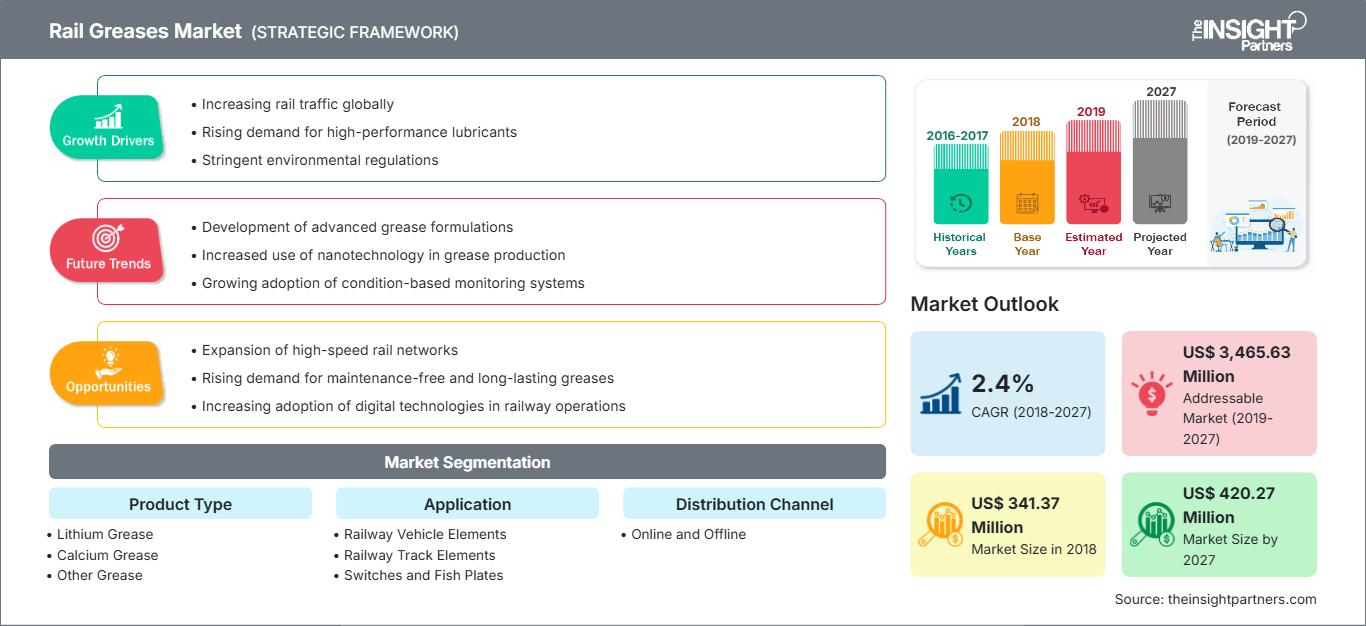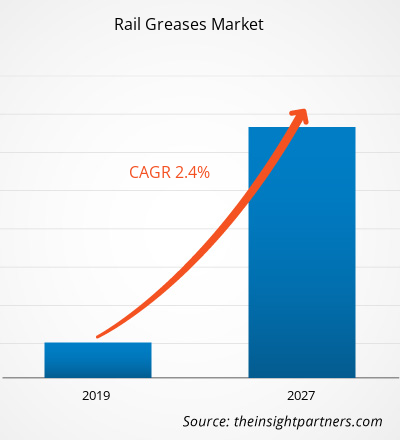철도 그리스 시장은 2018년 3억 4,137만 달러 규모였으며, 2027년에는 4억 2,027만 달러에 이를 것으로 예상됩니다. 2019년부터 2027년까지 연평균 성장률 2.4%로 성장할 것으로 예상됩니다.
그리스는 고체 또는 반고체 윤활유입니다. 일반적으로 미네랄 오일과 칼슘 기반 비누, 리튬 기반 비누와 같은 증점제로 구성됩니다. 그리스에는 이황화몰리브덴, 흑연, 폴리테트라플루오로에틸렌(PTFE)과 같은 추가 윤활 입자가 포함될 수도 있습니다. 다양한 종류의 그리스는 오일의 윤활 특성에 점착성을 더하여 윤활제가 표면에 더 잘 부착되도록 합니다. 그리스는 높은 초기 점도를 특징으로 하며, 이는 마찰을 유발합니다. 자동차, 철도, 건설, 제약, 식음료, 광업 등 다양한 산업 분야에서 널리 사용됩니다. 레일의 경우, 윤활이 자주 필요하고 윤활유가 오래 지속되지 않는 장치에 그리스를 사용할 수 있습니다. 그리스는 물과 비압축성 물질의 침투를 방지하는 밀봉제 역할을 합니다. 또한 그리스는 철도 차축 및 바퀴, 베어링 및 체인, 브레이크 요소, 내부 부품, 팬터그래프, 철도 궤도 부품 등 다양한 레일 부품의 유지보수에도 사용되어 오염 물질 유입이나 윤활유 손실을 방지합니다. 2018년 아시아 태평양 지역은 세계 레일 그리스 시장에서 가장 높은 시장 점유율을 기록하며 시장을 장악했으며, 예측 기간 동안 가장 빠르게 성장하는 지역으로 예상됩니다. 이 지역의 레일 그리스 시장 성장은 주로 경제 호황, 급속한 도시화, 그리고 신흥국 정부의 철도 인프라 개발 투자 증가에 기인합니다. 이 지역의 국가들은 도시 철도 시스템의 효율성, 신뢰성, 그리고 승객 친화적인 환경을 조성하기 위해 최첨단 교통 기술을 시험하고 있습니다. 아시아 태평양 지역의 지하철 시스템은 반자동에서 무인/무인 열차 운행으로 점진적으로 전환되고 있습니다. 대부분의 신설 시스템은 통근객의 편의와 안전을 위해 최첨단 기술 솔루션을 도입하고 있습니다. 따라서 이 지역의 철도 그리스 시장은 빠르게 성장할 것으로 예상됩니다. 또한, 이 지역의 기존 철도망 디지털화를 위한 다양한 정부 정책 또한 예측 기간 동안 철도 그리스 시장의 성장을 촉진할 것입니다.
이 보고서의 일부, 국가 수준 분석, Excel 데이터 팩을 포함하여 모든 보고서에 대한 사용자 정의를 무료로 받을 수 있을 뿐만 아니라 스타트업 및 대학을 위한 훌륭한 제안 및 할인을 이용할 수 있습니다
철도 그리스 시장: 전략적 통찰력

-
이 보고서의 주요 주요 시장 동향을 확인하세요.이 무료 샘플에는 시장 동향부터 추정 및 예측에 이르기까지 데이터 분석이 포함됩니다.
COVID-19 팬데믹은 2019년 12월 중국 우한에서 발생하여 전 세계로 빠르게 확산되었습니다. 2020년 7월 기준 확진자와 사망자 수 기준으로 가장 큰 피해를 입은 국가는 미국, 러시아, 인도, 이탈리아, 중국, 스페인, 프랑스, 독일입니다. 이 팬데믹은 강제 봉쇄, 여행 금지, 사업장 폐쇄로 경제와 산업에 큰 타격을 입혔습니다. COVID-19 확산 이후, 공급망 붕괴, 봉쇄로 인한 제조 차질, 그리고 이번 사태로 인한 사무실 폐쇄로 인해 여러 지역에서 철도 그리스 수요가 감소했습니다. 아시아 태평양 및 북미 등 주요 지역의 여러 공장들이 봉쇄되면서 철도 그리스의 제조, 납품 일정 및 판매가 영향을 받아 전 세계 철도 그리스 시장에 부정적인 영향을 미치고 있습니다.
시장 분석: 철도 운송에 사용되는 다양한 부품의 정기적인 유지보수 활동
차축 및 휠, 베어링 및 체인, 브레이크 부품, 내부 부품, 팬터그래프와 같은 철도 차량 부품은 원활한 작동과 고성능을 위해 정기적인 유지보수 및 윤활이 필요합니다. 휠에 그리스를 도포하면 인건비 절감, 수리 주기 연장, 윤활유 소비 감소 등 다양한 이점을 얻을 수 있습니다. 철도 차량 부품에 그리스를 사용하면 장비 신뢰성 향상, 예상치 못한 가동 중단 감소, 에너지 및 연료 소비 감소, 장비 수익성 향상 등 다양한 운영상의 이점을 얻을 수 있습니다. 또한, 그리스는 에너지 절약 및 소음 감소에도 도움이 될 수 있습니다. 차량-궤도 시스템의 차축 베어링은 철도 및 열차 대차의 중요한 구성 요소로, 궤도와 대차 사이에 발생하는 다양하고 복잡한 확률적 하중을 견뎌냅니다. 차축 박스 베어링의 신뢰성과 수명은 철도 안전에 영향을 미칠 수 있습니다. 그리스는 철도 차축 박스 베어링 윤활에 중요한 역할을 합니다. 차축 박스 베어링의 윤활 불량은 차축 과열 절단 및 베어링 소손과 같은 사고로 이어질 수 있기 때문입니다. 또한, 그리스는 궤도 부품, 브레이크, 내부 부품 등 다른 철도 부품에도 사용됩니다. 철도 궤도 부품에 사용되는 그리스는 마찰을 최소화하고, 온도를 낮추고, 차륜 플랜지와 레일 사이의 마모를 방지하도록 설계되었습니다. 또한, 철도 궤도 부품 설치에 사용되는 나사와 볼트에도 녹 방지를 위해 그리스가 사용됩니다. 따라서 레일 그리스는 주로 철도 차량 부품 및 철도 궤도 부품과 같은 다양한 부품의 유지보수 및 원활한 작동과 고성능을 위해 필요합니다. 이러한 사실은 예측 기간 동안 레일 그리스 시장을 주도했습니다.
유형 기반 분석
제품 유형에 따라 레일 그리스 시장은 리튬 그리스, 칼슘 그리스, 기타 그리스로 구분됩니다. 2018년 리튬 그리스 부문은 전 세계 철도 그리스 시장을 장악했으며, 예측 기간 동안 가장 빠른 성장률을 보일 것으로 예상됩니다. 리튬 그리스는 버터처럼 부드러운 질감과 350°F(175°C) 이상의 적점을 가진 다목적 그리스입니다. 또한, 최대 300°F(175°C)의 고온에서도 사용 가능합니다. 리튬 그리스는 내수성, 내열성, 내파괴성이 우수합니다. 리튬 기반 그리스는 다른 그리스에 비해 녹는점이 높아 철도 분야에서 가장 널리 사용됩니다. 리튬 그리스는 높은 펌핑성으로 인해 곡선형 톱니 커플링, 카르단 샤프트, 액슬 박스, 브레이크 시스템 등 철도 및 열차의 다양한 부품에 사용됩니다. 철도 운송에 사용되는 다양한 부품의 정기적인 유지보수 활동은 예측 기간 동안 리튬 그리스 수요를 견인할 것으로 예상됩니다.
응용 분야 기반 분석
레일 그리스 시장은 용도에 따라 철도 차량 요소, 철도 궤도 요소, 스위치 및 피시 플레이트, 곡선 레일, 나사 및 볼트로 구분됩니다. 철도 차량 요소 부문이 세계 레일 그리스 시장을 장악했으며, 곡선 레일 부문은 예측 기간 동안 가장 빠른 성장률을 보일 것으로 예상됩니다. 윤활제는 곡선 궤도에서 차륜과 레일의 과도한 마모를 제어하기 위해 널리 사용됩니다. 그리스와 오일은 일반적으로 곡선 궤도의 외측(고측) 레일의 궤간면에 도포되며, 차륜과 레일 마모를 줄이는 것 외에도 레일 끝단의 마모와 파상(corrugation) 증가 속도를 줄이는 것으로 나타났습니다. 최근 연구에 따르면 효과적인 윤활은 에너지 및 연료 소비를 줄이는 추가적인 이점을 제공하며, 이로 인해 많은 철도 엔지니어들이 윤활 관리에 더욱 주의를 기울이고 있습니다. 이는 전 세계적으로 레일 그리스 수요를 더욱 증가시킵니다. 또한, 곡선 구간에서는 고측 레일(외측 곡선) 차륜이 궤간면을 따라 주행합니다. 이로 인해 반연속 마찰이 발생하여 궤간면과 차륜 플랜지의 마모가 크게 발생합니다. 차륜과 레일 접촉면 사이의 강한 접촉 마찰력은 궤도 곡선에서 소음을 발생시킵니다. 따라서 그리스는 마찰을 줄이기 위해 사용됩니다. 특히, 급커브 구간이 많은 도심 지역에서 윤활 시스템은 악명 높은 곡선 소음을 줄이는 해결책을 제공합니다. 그리스는 궤간면과 레일 상단의 마모와 곡선 소음을 줄이는 데 사용됩니다. 따라서 레일의 경제적 수명을 향상시키기 위해 곡선 레일 윤활은 쉽고 경제적인 해결책으로 여겨져 왔습니다.
유통 채널 기반 분석
유통 채널을 기준으로 레일 그리스 시장은 오프라인과 온라인으로 구분됩니다. 오프라인 부문이 전 세계 레일 그리스 시장을 장악한 반면, 온라인 부문은 예측 기간 동안 더 빠른 성장률을 보일 것으로 예상됩니다. 전 세계적으로 디지털 채널 도입이 증가함에 따라 온라인 유통 채널에 대한 중요성이 더욱 커지고 있습니다. 전 세계적으로 인터넷 사용률과 스마트폰 보급률이 증가하고 있으며, 소비자들은 제품 조사부터 최종 구매 결정까지 모든 과정을 온라인으로 처리하는 경향이 커지고 있습니다. 편의성, 빠른 배송, 안전한 결제 옵션과 같은 여러 가지 이점 덕분에 B2B 구매자들이 온라인 구매를 선호하고 있습니다. 따라서 철도 그리스 시장에서 활동하는 기업들은 지난 몇 년간 경쟁에 발맞춰 사업을 지속적으로 성장시키기 위해 유통 전략을 최적화해 왔습니다. 기업들은 기존 오프라인 유통 채널과 더불어 온라인 유통 채널을 활용하여 시장의 많은 고객을 타겟팅하고 도달하고 있습니다. 또한, 온라인 유통 채널은 기업이 추가 비용이나 경비 없이 목표 소비자에게 도달할 수 있도록 지원합니다. 따라서 윤활유 및 그리스 제조업체들은 온라인 매장을 개설하고 판매를 통해 수익을 창출하기 위해 전자상거래 산업을 활용하고 있습니다.
Royal Dutch Shell Plc(Shell), Exxon Mobil Corporation, Total SA, BP Australia Pty Limited, Petroliam Nasional Berhad(Petronas), SKF Group, FUCHS, Chevron Corporation, Klüber Lubrication, Sinopec Corp. 등이 글로벌 철도 그리스 시장의 주요 기업입니다. 이 시장의 회사들은 전 세계적으로 영향력을 확대하고 시장의 증가하는 수요를 충족하기 위해 제품 개발, 공장 확장, 합병 및 인수와 같은 전략에 지속적으로 집중해 왔습니다.
레일 그리스 시장The Insight Partners의 분석가들은 예측 기간 동안 철도 그리스 시장에 영향을 미치는 지역별 동향과 요인을 면밀히 분석했습니다. 이 섹션에서는 북미, 유럽, 아시아 태평양, 중동 및 아프리카, 그리고 중남미 지역의 철도 그리스 시장 부문 및 지역별 현황도 다룹니다.
레일 그리스 시장 보고서 범위
| 보고서 속성 | 세부 |
|---|---|
| 시장 규모 2018 | US$ 341.37 Million |
| 시장규모별 2027 | US$ 420.27 Million |
| 글로벌 CAGR (2018 - 2027) | 2.4% |
| 이전 데이터 | 2016-2017 |
| 예측 기간 | 2019-2027 |
| 다루는 세그먼트 |
By 제품 유형
|
| 포함된 지역 및 국가 |
북미
|
| 시장 선도 기업 및 주요 회사 프로필 |
|
철도 그리스 시장 참여자 밀도: 비즈니스 역학에 미치는 영향 이해
철도 그리스 시장은 소비자 선호도 변화, 기술 발전, 그리고 제품 이점에 대한 인식 제고 등의 요인으로 인한 최종 사용자 수요 증가에 힘입어 빠르게 성장하고 있습니다. 수요가 증가함에 따라 기업들은 제품 라인업을 확장하고, 소비자 니즈를 충족하기 위한 혁신을 추진하며, 새로운 트렌드를 적극 활용하고 있으며, 이는 시장 성장을 더욱 가속화하고 있습니다.

- 을 얻으세요 철도 그리스 시장 주요 주요 플레이어 개요
글로벌 레일 그리스 시장 - 유형별
- 리튬 그리스
- 칼슘 그리스
- 기타 그리스
글로벌 레일 그리스 시장 - 용도별
- 철도 차량 요소
- 철도 궤도 요소
- 스위치 및 피쉬 플레이트
- 곡선 레일
- 나사 및 볼트
글로벌 레일 그리스 시장 - 유통 채널별
- 오프라인
- 온라인
회사 프로필
- Royal Dutch Shell Plc (Shell)
- Exxon Mobil Corporation
- Total SA.
- BP Australia Pty Limited
- Petroliam Nasional Berhad (Petronas)
- SKF Group
- FUCHS
- Chevron Corporation
- Klüber Lubrication
- Sinopec Corp
- 과거 분석(2년), 기준 연도, CAGR을 포함한 예측(7년)
- PEST 및 SWOT 분석
- 시장 규모 가치/거래량 - 글로벌, 지역, 국가
- 산업 및 경쟁 환경
- Excel 데이터세트
최근 보고서
관련 보고서
사용 후기
구매 이유
- 정보에 기반한 의사 결정
- 시장 역학 이해
- 경쟁 분석
- 고객 인사이트
- 시장 예측
- 위험 완화
- 전략 기획
- 투자 타당성 분석
- 신흥 시장 파악
- 마케팅 전략 강화
- 운영 효율성 향상
- 규제 동향에 발맞춰 대응






















 무료 샘플 받기 - 철도 그리스 시장
무료 샘플 받기 - 철도 그리스 시장